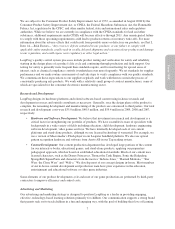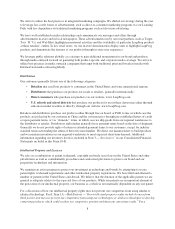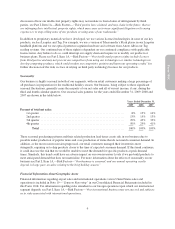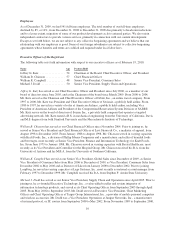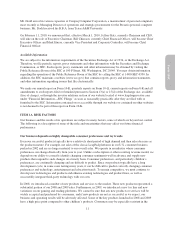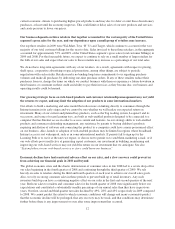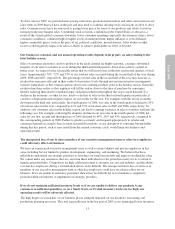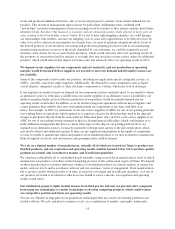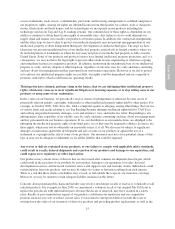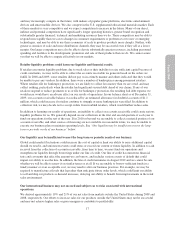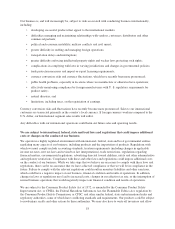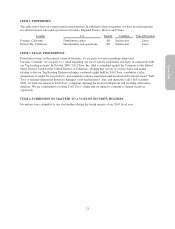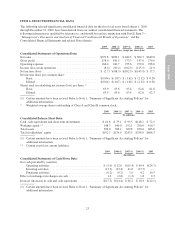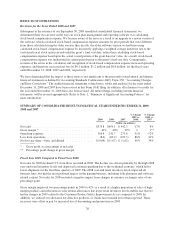LeapFrog 2009 Annual Report Download - page 27
Download and view the complete annual report
Please find page 27 of the 2009 LeapFrog annual report below. You can navigate through the pages in the report by either clicking on the pages listed below, or by using the keyword search tool below to find specific information within the annual report.
and may increasingly compete in the future, with makers of popular game platforms, electronic entertainment
devices and smart mobile devices. We also compete in the U.S. supplemental educational materials market. Each
of these markets is very competitive and we expect competition to increase in the future. Many of our direct,
indirect and potential competitors have significantly longer operating histories, greater brand recognition and
substantially greater financial, technical and marketing resources than we do. These competitors may be able to
respond more rapidly than we can to changes in consumer requirements or preferences or to new or emerging
technologies, and may be able to use their economies of scale to produce products more cheaply. Further, with
greater economies of scale and more distribution channels, they may be successful even if they sell at a lower
margin. Our larger competitors may also be able to devote substantially greater resources, including personnel,
spending and facilities to the development, promotion and sale of their products than we do. We cannot assure
you that we will be able to compete effectively in our markets.
Retailer liquidity problems could harm our liquidity and financial results.
If retailers encounter liquidity problems due to weak sales or their inability to raise sufficient capital because of
credit constraints, we may not be able to collect the accounts receivable we generate based on the orders we
fulfill. In 2008 and 2009, some retailers did not pay us in a timely manner and others indicated that they would
be unable to pay any vendors. In addition, there were a number of bankruptcies among prominent retailers.
Where retailers file for bankruptcy protection, we are likely to collect less money than we are owed, and may
collect nothing, particularly when the retailer had significant secured debt ahead of our claims. If any of our
retailers suspend or reduce payments to us or file for bankruptcy protection, the resulting bad debt expense we
would incur would have an adverse effect on our results of operations. In our balance sheet as of December 31,
2009, our accounts receivable balance was reduced by an estimated allowance for doubtful accounts of $1.1
million, which could increase if retailers continue to struggle or more bankruptcies were filed. In addition to
collection risk, we may decide not to accept orders from troubled retailers, which would further reduce sales.
In addition to harming our results of operations, an inability to collect on accounts receivable could create serious
liquidity problems for us. We generally depend on our collections in the first and second quarters of each year to
fund our operations for the rest of the year. If in 2010 or beyond we are unable to collect a material portion of our
accounts receivable, and other sources of financing are not available on reasonable terms, we may be unable to
execute our business plan or maintain operating levels. See “Our liquidity may be insufficient to meet the long-
term or periodic needs of our business” below.
Our liquidity may be insufficient to meet the long-term or periodic needs of our business.
Global credit market fluctuations could increase the cost of capital or limit our ability to raise additional capital
should we need it, and unforeseen events could stress or exceed our current or future liquidity. In addition to cash
received from the collection of accounts receivable, from time to time, we may fund our operations and
strengthen our liquidity through borrowings under our line of credit. Our line of credit has numerous financial
tests and covenants that affect the amount we can borrow, and includes various events of default that could
impair our ability to use the line. In addition, the line of credit terminates in August 2012 and we cannot be sure
whether we will be able to renew it on similar terms or at all. If we are unable to borrow sufficient funds in a
timely manner or at an acceptable cost, we may need to alter our business practices. For example, we may be
required to manufacture at levels that lag rather than anticipate future order levels, which could limit our ability
to sell and ship our products as demand increases, delaying our ability to benefit from improvements in the retail
sales environment.
Our international business may not succeed and subjects us to risks associated with international
operations.
We derived approximately 19% and 21% of our net sales from markets outside the United States during 2009 and
2008, respectively. Our efforts to increase sales for our products outside the United States may not be successful
and may not achieve higher sales or gross margins or contribute to profitability.
17


